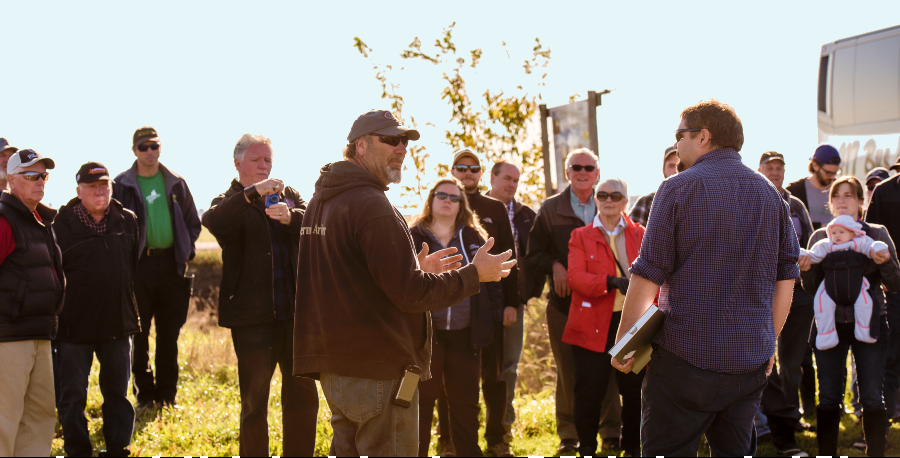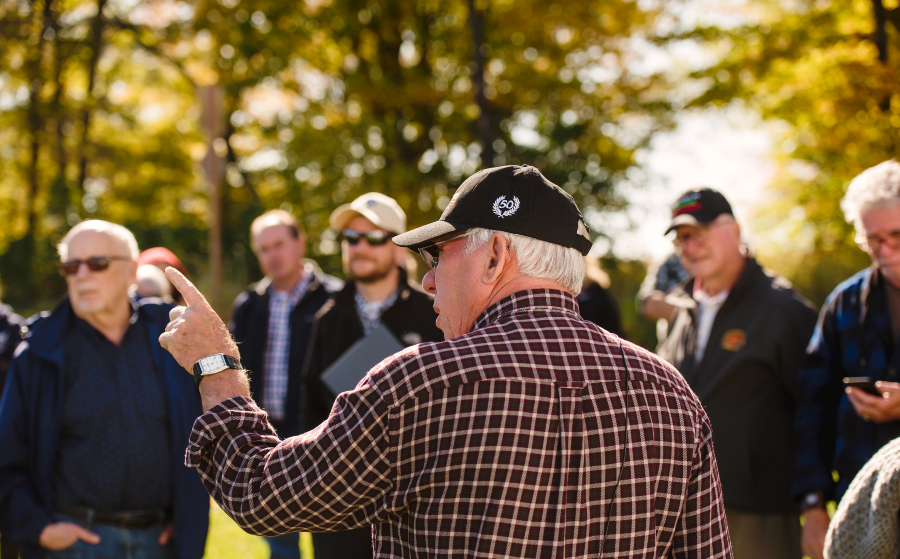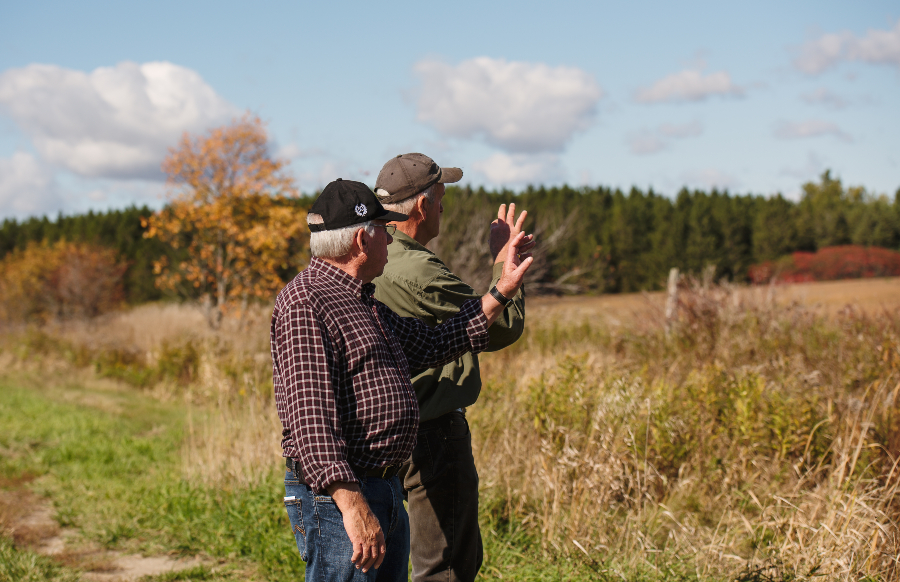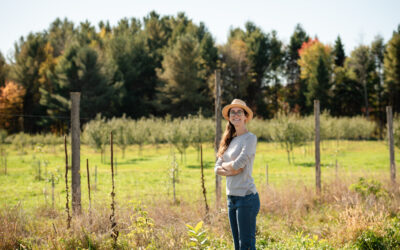ALUS Ontario East participants explain how—and why—they do what they do.

ALUS Ontario East PAC member Marc Bercier manages an ALUS wetland project with four ponds and a 600 metre riparian buffer planted with native trees, berry shrubs and flowering plants, all to produce better wildlife habitat and control gully erosion.
On a balmy day in early October, ALUS Ontario East participants Kurt MacSweyn, Mike MacGillivray, Christian Lalande, André Pommainville and Marc Bercier got ready to receive 45 guests on their farms, located east of the capital region.
Brendan Jacobs, ALUS Ontario East’s Program Coordinator, organized this “Agri-Action Environmental Stewardship Tour,” in partnership with the Raisin Region Conservation Authority, to showcase five types of ALUS projects in the United County of Prescott-Russell and the Township of North Glengarry.
The first stop of the tour was at ALUS Ontario East PAC member Marc Bercier’s Ferme Agriber in St. Isidore.
Guests learned about an extensive ALUS wetland project featuring four interconnected settling ponds and a 600-metre riparian buffer planted with native trees, berry shrubs and flowering plants.
Chris Craig, Senior Forestry Technician with South Nation Conservation (SNC), explained how First Nations’ traditional knowledge informed the choice of native species that SNC planted along the ALUS buffer this past spring.
The ALUS project is already producing better fish, bird and pollinator habitat, while helping to control gully erosion and produce cleaner water for the nearby Scotch River.
“The goal is to see good, clean water exiting our fields,” said Bercier, “and also to pay attention to our gullies and stop gully erosion, to retain that water.”
“When we put in tile drainage years ago, we opened the taps. The water drains very quickly off the fields; that’s why the Ottawa River rises so quickly, and why we now have drought in the summertime. So we need to keep the water on the farmland, and keep the water level high.”

There were lots of questions for ALUS participant and former PAC Chair André Pommainville, who farms 300 acres along the Ottawa River and maintains a buffer zone around a slough through ALUS.
There were lots of questions for ALUS participant and past PAC Chair André Pommainville at the second stop on the tour, in Alfred, where Pommainville farms 300 acres along the Ottawa River.
He has several tree-planting projects, one established in partnership with a Butternut recovery program, and an ALUS project, established in partnership with SNC and Forest Ontario.
The ALUS project consists of 1,500 jack pine, white spruce, Norway spruce and Eastern white cedar, creating a buffer zone around a slough, where the water can rise to six or seven feet high in spring.
“The idea is to lower peak flows,” Jacobs explained. “ALUS projects help lengthen the time lag from the moment a raindrop hits the soil to the moment it gets into a watercourse and makes its way downstream.”

ALUS participant Christian Lalande shows Andre Pommainville and the group a range of ALUS project options he is considering to improve three boggy areas of his farm.
Just before lunch, the tour stopped in L’Orignal, where ALUS participant Christian Lalande showed some of the boggy areas on his farm, and explained the range of ALUS project options he is considering to improve them.
One idea is to create ponds, which would retain water on the landscape, with buffer areas around them, which would enhance wildlife habitat. Together, these ALUS projects would help filter the water exiting the tile-drainage system before it flows off Lalande’s land and into local waterways.
The tour had lunch in Vankleek Hill, where keynote speaker Eric Payseur, of Canadian Organic Growers, presented the advantages of organic growing methods for farmers trying to adapt to the effects of climate change.
The group then made two stops in the North Glengarry sector of ALUS Ontario East’s large territory.
At Kirkview Farms in Dalkeith, ALUS participant Mike MacGillivray explained his brand of land stewardship during a guided tour of his ALUS projects: a series of windbreaks, consisting of more than 5,000 native trees and shrubs planted in partnership with the RRCA and Forest Ontario.
MacGillivray manages and maintains these ALUS projects to retain topsoil and enhance water infiltration, producing cleaner water for the community, as well as cleaner air and more wildlife habitat.
In fact, MacGillivray has already noticed an increase in wildlife activity on his farm.
“We used to see just a few birds in the fields, following the cattle around, but now we see flocks of swallows, lots of garter snakes and spiders too,” he remarked.

At Kirkview Farms in Dalkeith, ALUS participant Mike McGillivray explained his brand of land stewardship during a guided tour of his ALUS projects.
The final stop of the tour was at Dalagra Farms in Laggan, where ALUS Ontario East PAC member Kurt MacSweyn and his family grow corn, soy and hops while managing 30 acres of ALUS projects along one of the main branches of the Rigaud River.
Specifically, the MacSweyns have incorporated floodplain and riparian buffer projects on their riverside land. The aim of these projects is to retain tree cover, reduce water flow and filter runoff water to benefit communities downstream.
“Around here, everything was tile-drained about 60 years ago, so when there is heavy rain or quick snowmelt, all that water gets pumped into the ditches at the same time,” said MacSweyn.
“It’s an instant rise in the streams and rivers, and there’s a snowball effect as you get further downstream and you see that dramatic spring flooding. But then, our stream goes dry at the end of summer—it gets right down to the bedrock with just pockets of water left.”
“So that is why we are trying to keep more water on the property longer,” he concluded.

At Dalagra Farms in Laggan, ALUS Ontario East PAC member Kurt MacSweyn and his family grow corn, soy and hops while managing 30 acres of ALUS projects along one of the main branches of the Rigaud River.
Jacobs reports that he received a number of expressions of interest at the conclusion of the tour, as well as developed some new partnership avenues.
“The event was a success, in that it raised awareness of the ALUS program locally and informed landowners, farmers and municipal councils of the importance of our on-farm restoration activities,” he said.
“We are hoping that this increased awareness will also lead to an increase in funding for watershed restoration.”
For more information, visit the ALUS Ontario East webpage.
ALUS is grateful to the Intact Foundation for funding the tour as part of a generous donation of $248,850 to ALUS Canada. For more information, see our Intact funding announcement here.
We also thank the Ontario Wildlife Federation, the Eastern Ontario Water Resource Program, OMAFRA, the Raisin Region Conservation Authority (RRCA), South Nation Conservation (SNC), Canadian Organic Growers, ALUS Ontario East PAC members and participants, and everyone who joined us on the fall 2019 community tour of ALUS projects in eastern Ontario.



